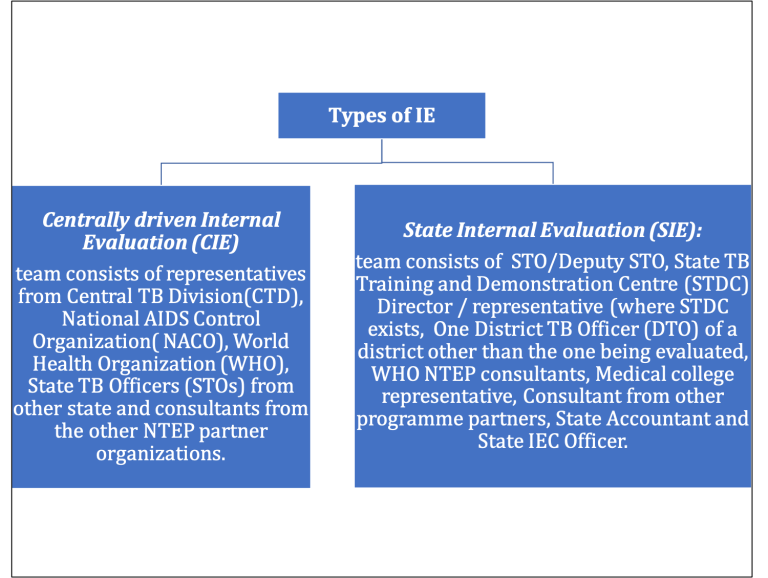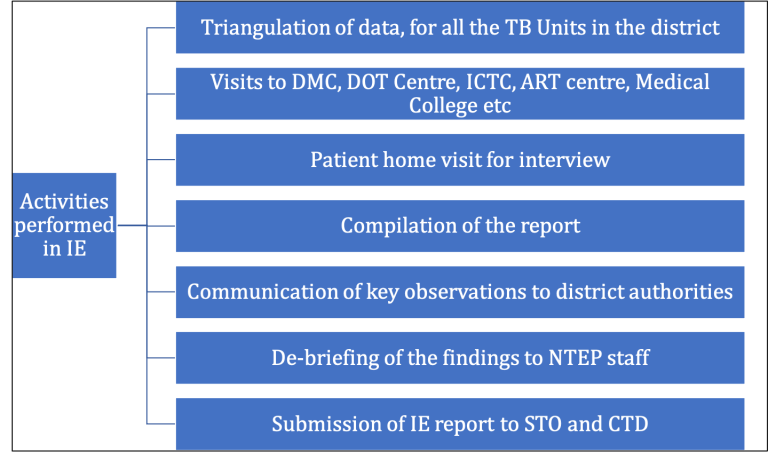Content Status
Type
Linked Node
Internal Evaluation
Learning Objectiveswhat is internal evaluation, the concept and how it is done
Introduction
Internal Evaluation (IE) is a process of critically evaluating a programme by the programme people to understand determinants of both good and poor performance and enable uptake of the strategic measures for improvement. IE is an integral component of the National Tuberculosis Elimination Programme’s (NTEP) supervision and monitoring strategy.
Objectives of IE
1. To provide a systematic framework for assessing programme performance, financial & logistics management, recording and reporting, and quality of care received by patients.
2. To give recommendations for improving the quality of programme implementation and performance with a realistic action plan and timeline.
3. To monitor efforts to improve and maintain programme quality and performance over time.
Types of IE

IE Methodology
-
Selection of Districts:
At least one good-performing district and one under-performing district should be selected. For states with population up to 30 million – 2 districts per quarter; 30-100 million – 3 districts per quarter; >100 million – 3-4 districts per quarter should be evaluated. In States/Union Territories (UTs) with 4 or less districts, 1 district or Tuberculosis Unit (TU) per quarter may be evaluated.
-
Selection of TB Units/ Designated Microscopy Centres (DMCs):
Five DMCs are selected as follows:
-
DMC at District TB Centre (DTC)
-
Two DMC that are examining a higher number of persons with presumed TB (preferably from different TU)
-
Fourth and fifth DMC are selected randomly from the remaining DMCs (preferably from different TU)
-
Selection of Directly Observed Treatment (DOT) Centres:
The DOT Centres attached to each of the 5 selected DMCs (and Medical College conveniently selected) should be evaluated.
5 additional DOT Centres must be identified in the district with unique characteristics such as those attached to a medical college (other than the one conveniently selected for a visit), other sectors like ESI, Railways, NGOs, private sector, Anganwadi workers, Accredited Social Health Activist (ASHA), community volunteer) and evaluated.
d) Selection of Patients:
A total of 36 to 39 patients should be interviewed in the district.
-
In each of the 2 DMCs with a low caseload, 4 New Smear Positive (NSP) patients are selected randomly, and one previously treated case conveniently (5 X 2= 10 patients).
-
In each of the DMCs at DTC & 2 TU level DMC, 4 NSP patients are selected randomly, and 1 patient, each of the types Relapse, Treatment after Loss to Follow up (LFU) and Failure, are conveniently selected.
-
Also select 1 TB/HIV patient and 1 DOTS-Plus patient (for districts implementing DOTS-Plus) (7 X 3 =21 + 3 +3= 27).
-
At least 2 paediatric patients undergoing DOTS treatment within the district must be visited.
IE Activities

Resource
Assessment
|
Question |
Answer 1 |
Answer 2 |
Answer 3 |
Answer 4 |
Correct answer |
Correct explanation |
Page id |
Part of Pre-test |
Part of Post-test |
|
Which of the following is an objective of IE? |
To provide a systematic framework for assessment of programme performance. |
To give recommendations for improving the quality of the programme. |
To monitor efforts to improve and maintain programme quality and performance over time. |
All of the above |
4 |
The objectives of IE are: 1. To provide a systematic framework for assessment of programme performance, financial & logistics management, recording and reporting, and quality of care received by patients. 2. To give recommendations for improving the quality of programme implementation and performance with a realistic action plan and time line. 3. To monitor efforts to improve and maintain programme quality and performance over time. |
|
Yes |
Yes |
Content Creator
Reviewer
Target Audience
- Log in to post comments